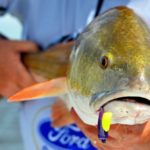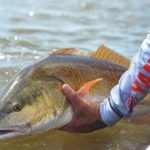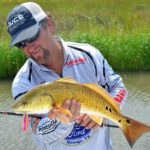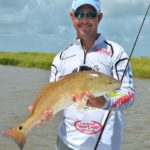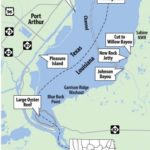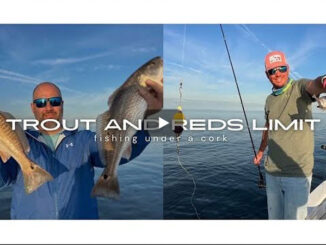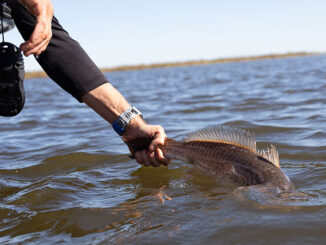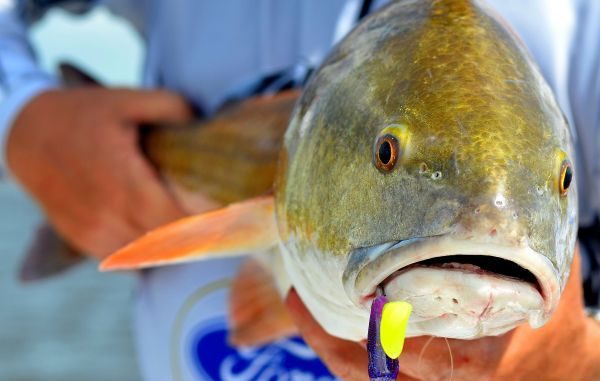
In April, numerous schools of Sabine Lake redfish invade the eastern, Louisiana shoreline chasing baitfish schools in and out of the marshes. Read on for locations, tips and tactics offered by two local tournament anglers toward catching a hefty limit of
Several schools of redfish stretching a quarter mile were heading toward the marshes. They were in feeding mode, smashing into juvenile pogies during a steep incoming tide.
“Look at the slick here,” 42-year-old Brian “Freddy” Frederick said while casting a pink/gold Heddon One Knocker Spook.
“There’s fish right behind my bait now,” 39-year-old Jerrod “J-Rod” Broussard said in response.
Broussard was retrieving an Egret Baits, glow/chartreuse Wedgetail Mullet when his cork disappeared.
Setting the hook hard, he smiled as the water exploded and a hefty redfish appeared. While the angler’s reel drag sang, Broussard turned his head toward other sounds coming from the boat’s back deck.
Frederick was obviously struggling and frustrated.
“What’s the deal, you broke?” Broussard asked.
“Yeah, I’m hand-lining in a fish,” Frederick said.
Frederick’s line had snapped because of a significant wind knot after a redfish smashed his One Knocker.
Broussard had his slot red flapping on the deck while Frederick continued to wind up braid with his hands, resulting in verbal acclaims of pain of thin cuts caused by the line when the red would lunge.
Frederick finally made a sweeping motion, and the second redfish was aboard.
Broussard’s fish measured a tad over the upper slot mark of 28 inches. Frederick’s fish was within the slot but still a personal trophy due to the circumstances.
After a brief round of photos, both fish were released back into Sabine Lake.
The abundant baitfish and incoming tide had redfish and slicks popping up everywhere in this location.
“These fish are coming out in the middle of this cove,” Broussard said. “We thought they would come out on the banks earlier, but it didn’t happen.
“So here they are out in the middle in schools and pushing the baitfish up.”
Frederick caught the largest fish on top, a 30-incher. Only two of the 15 fish taken and released that morning were above the 27-inch slot limit.
“The tide is sweeping this point out in front of us,” Frederick said. “There’s some scattered shell bottoms in here.
“It’s in the pocket where we are catching these fish.”
Frederick and Broussard are redfish tournament anglers targeting coastal waters of Southwest Louisiana and Texas who share a strong passion for this species.
The team has won and placed in many redfish tournaments in over the years.
Finding and catching redfish on this trip were not difficult tasks for these anglers from nearby Port Neches on the lake’s western border. Longtime residents of the area, this pair has fished together most of their lives.
So they know the habits of most species of fish in the vast Sabine Lake estuary.
We were out to simply catch a few redfish from Sabine Lake’s many schools that prowl both the lake and interior marshes to the north and east.
The lake stretches 23 miles north and south, and nine miles across, and is fed by the Sabine and Neches rivers. This does not include the bayous and marsh inlets to the east, including waters within the Sabine National Wildlife Refuge.
Although there are always redfish somewhere in the vast Sabine Lake estuary, April is prime time.
“Redfish here will be moving out from the cold, deep waters of the Sabine jetties and the channel,” Frederick said. “On the east side of the lake, they will be headed to the marshes, chasing schools of juvenile pogies and other small baitfish.”
Frederick advised that incoming tides are best to find schools and smaller pods along the eastern shoreline of the lake.
“Look for reds breaking the surface on baitfish,” he said. “You will find surface activity on any given day on the east side.”
The anglers usually start on the southern end of the lake, heading north along the eastern shoreline.
“You can fish the jetties and southern end when launching from the Causeway,” Broussard said. “Anglers can also find redfish working scattered shell near shorelines from southeastern Blue Buck Point all the way to Coffee Ground Cove on the northeastern border of the lake.”
Frederick advised anglers to troll slowly along the eastern shoreline.
“Look at the surface of the waters, and see where the wind and tides are pushing bait onto the points,” he said. “And watch very carefully, because some of the surface activity is not all that disruptive.
“It could be a few baitfish jumping or wakes along the shoreline.”
In early April, these anglers find slicks as they troll north. Those are signs almost proof positive redfish are roaming the shallower shorelines. Of course, speckled trout foraging on baitfish can also cause these oily, round patches on the water’s surface.
“But don’t expect to see redfish tailing or their backs above the waters in the lake or along shorelines,” Frederick said. “And the birds here may or may not be working by late April.”
Bayous and navigable channels into the marshes accent the eastern shorelines offer prime areas to locate redfish schools.
Running north from the jetties are Johnson, Willow, Bridge, Three and Whiskey bayous along the eastern shoreline, Broussard said.
Some of the shoreline bayous give access to the Sabine NWR, and it’s best to know the regulations of the refuge before fishing inside its borders.
Also, skinny waters off bayous outside the borders of Sabine NWR are mostly private property. By Louisiana law, private marshlands do not have to be posted, and anglers can be cited with trespass charges.
In the bayous and marshes within the Sabine NWR that are open for access, an outgoing tide is favorable.
And action picks up as temperatures rise.
“In the refuge and the marshes available there, we do better as the waters warm even more,” Broussard said.
Anglers can motoring down the bayous and then troll toward the lake to get better views of surface activity. Redfish frequently move from marsh cuts into the bayous and canals to pounce on baitfish.
“Look for bait — that’s most important,” Broussard said. “If there is no bait, you may as well move on elsewhere because the redfish won’t be there.”
Caution: Know the regs
Accessing the Sabine River National Wildlife Refuge’s interior marsh through some of the cuts in the bayous and canals off Sabine Lake is prohibited.
So it’s wise to consult the refuge’s regulations at www.fws.gov/southeast/pubs/SWLAcomplex_Fish.pdf.
Also, fishing within Sabine NWR’s borders when entering from Sabine Lake is permitted only from March 15 through Oct. 15 of each year.
